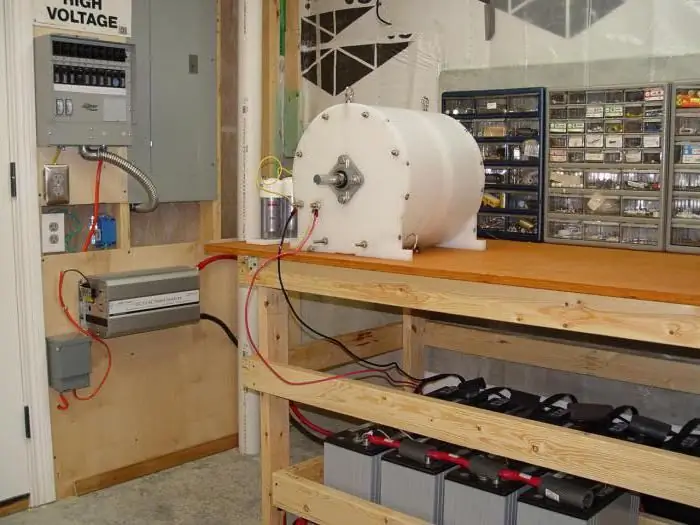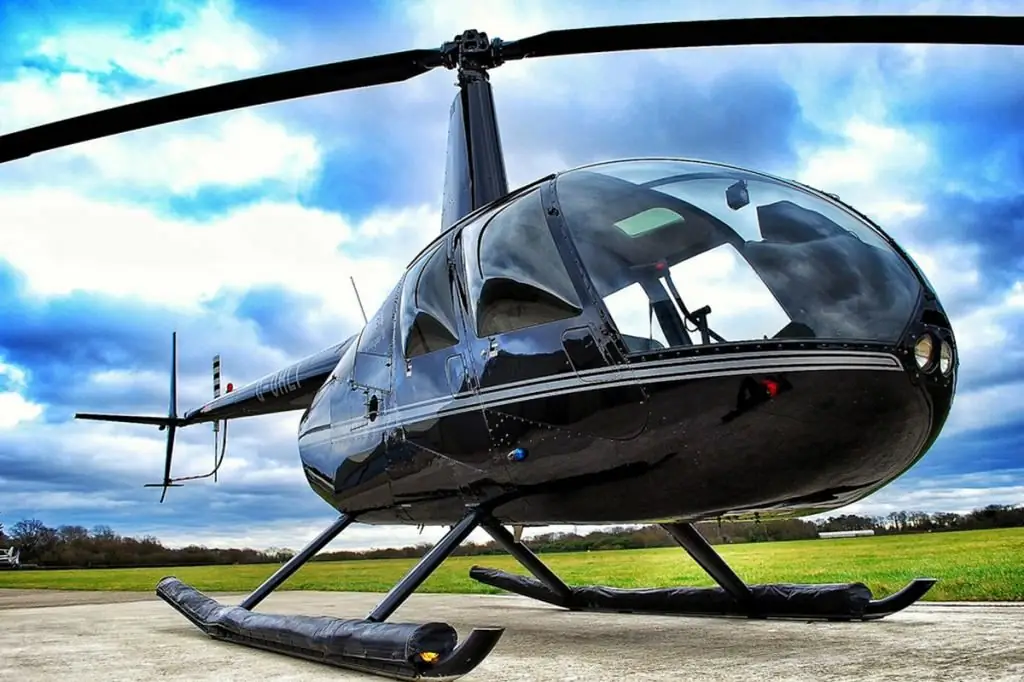2026 Author: Howard Calhoun | [email protected]. Last modified: 2025-01-24 13:10:26
The event of January 13, 1942, when the Sikorsky helicopter, intended for military purposes, was raised into the air, can be considered a full-fledged launch of the world's first helicopter, albeit a military one. The aircraft designer began the development of helicopters in pre-revolutionary Russia, continuing them in exile in the United States. Since then, a lot of time has passed, the design of helicopters has undergone significant changes, but the goals of using technology have remained the same.
Helicopter design

In all schemes of helicopters, the same main parts are distinguished:
- Main rotor. Generates propulsion and lift and controls the helicopter. Structurally, it consists of blades and a bushing that transmits torque from the main gearbox shaft to the blades.
- Tail screw. The directional control of a single-rotor helicopter compensates for the reactive torque of the main rotor. Its design includes a bushing and blades attached to the tail gear shaft.
- Swashplate. Controls the cyclic and collective pitch of the main rotor, transmits signals from the control circuit to the axial hinge of the hub, and then toblades.
- Control system. Helicopters are equipped with three independent control systems: directional, longitudinal-transverse and controlling the common pitch of the propeller. Such systems include in-cab levers, force gradient mechanisms, rockers and traction, swashplate, and hydraulic boosters.
- Transmission. Transmits power to propellers and auxiliaries from engines. The number and placement of engines, as well as the layout of the helicopter determine the design of the transmission.
- Fuselage. The main components of the helicopter are attached to it. Designed to accommodate passengers and cargo, fuel, equipment.
- Wing. Generates additional lift, reducing the load on the main rotor and increasing the speed of the helicopter. The wings can also accommodate equipment, fuel tanks and niches to hide the chassis. The rotors in transverse helicopters are supported by the wing.
- Plumage. Provides balance, stability and controllability of the helicopter. It is divided into two types - vertical, or keel, and horizontal, or stabilizer.
- Helicopter takeoff and landing parts. Designed for parking a helicopter, extinguishing kinetic energy during landing and movement on the ground. Many helicopters have landing gear retracted in flight.
- Helicopter engine. Generates the power needed to power the accessories, main drive and tail rotors. The power plant combines several engines with systems that ensure their stable operation in different modes.
Helicopter types

Helicopters are divided into several types. Each type has its own characteristics, strengths and weaknesses.
Single-rotor helicopters
The most common type of helicopter device is a single-rotor machine with a tail rotor. The advantage of this design lies in its simplicity - one transmission, one screw, easy operation. About 8-10% of the engine power is used to operate the tail rotor while hovering in the air, about 3-4% - during translational flight. Relatively light weight and simple design compensate for such power losses. The disadvantage of such a device for helicopters is the danger that threatens ground personnel from the tail rotor.
Zhirodin
The propeller axis of such helicopters, compensating for torque, is directed along the flight. This design allows you to create thrust without resorting to the use of a main rotor. This increases its efficiency, since there is no need to tilt it forward. The torque compensating screw of the main rotor is placed in such a way as not to form drag and increase the power supplied to the compensating screw.
Jet helicopter

The device of this model is an easy way to solve the torque problem. It is generated by the motors located at the end of the blades, but is not transmitted through the shaft. Only the moment of friction of the bearings is transmitted to the fuselage.
Jet engines create jet thrust. This type of rotor has a simple structure, which is its advantage;among the disadvantages is high fuel consumption.
Coaxial helicopter
Two screws of a coaxial helicopter, located one above the other and rotating in opposite directions, dampen the moment transmitted to the fuselage. The only requirement for the screws is the same torque.
Coaxial helicopters are inferior to single-rotor ones in size, but the torque is not compensated for by the power, which is possible due to the design of helicopters.
Transverse Rotor Helicopters

The advantage of such a helicopter lies in the reduction of the power required for forward movement. This is especially important in multi-engine helicopters, which must continue to move in a horizontal direction with the engine stopped.
The disadvantage of such machines is high resistance due to the frontal resistance of the structure on which the rotors rest. The streamlining and downsizing of the structure increases the weight of the helicopter.
The transverse rotor helicopter has a more complex transmission and larger dimensions, although they are affected by the degree of rotor overlap. One of the largest and heaviest helicopters of this design is the Mi-12.
Forward-rotor helicopter
A roomy fuselage and the ability to shift the center of gravity are the advantages of this helicopter design. The payload is distributed between the rotors. The complicated transmission and its heavy weight are the main disadvantages of helicopters with transverselocation of screws.
The second disadvantage is the reduced efficiency of the propellers, as the jets of their work intersect. In forward flight, the quality loss is reduced due to the fact that the rear propeller is located higher than the front one. How many blades does a helicopter of this design have? Propeller diameter and number of blades may vary to improve machine handling and stability.
Multi-rotor helicopters

Projects of multi-rotor helicopters developed by aircraft designers involved the creation of heavy models of machines. Due to several main rotors, control is simplified, since the helicopter can be rotated about any of the three axes by increasing the thrust of a particular propeller. The multi-rotor scheme of heavy helicopters allows you to keep the diameter of the screws within certain limits.
Recommended:
Classification of engines. Types of engines, their purpose, device and principle of operation

Nowadays, most vehicles are powered by an engine. The classification of this device is huge and includes a large number of different types of engines
Organization of an internal control system in an organization: creation, purpose, requirements and analysis

Any profitable enterprise carries a potential profit for its owner. What competent entrepreneur would not be interested in the conditions of functioning of his own offspring, bringing him such serious income? It is precisely because every businessman in his right mind and with an objective attitude to the management of his company is afraid of losing his profit and becoming bankrupt one day, he introduces a system of internal control over the organization's activities
Universal drive: types, device and purpose

Today, the development of technology has advanced quite widely, and those operations that were previously performed by two different devices can be performed by just one machine. A striking example of such progress was the universal drive
The lightest helicopter. Light Russian helicopters. Light helicopters of the world. The lightest multi-purpose helicopter

Heavy combat helicopters are designed to transport people, weapons and their use. They have serious armor, high speed. But they are not suitable for civilian purposes, they are too large, expensive and difficult to manage and operate. For peacetime, you need something simple and easy to manage. The lightest helicopter with a joystick control is quite suitable for this
Boiler house dispatching: organization, control system and purpose

Spatching of the boiler room: the main objectives of its implementation. Completeness of a typical automation and dispatching system. Controlled parameters and management. Description of the operation of this system and its advantages. Conducting dispatching by contractors

